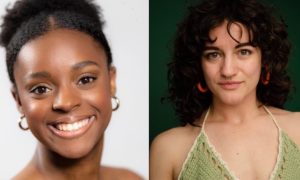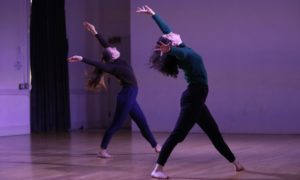By Kathleen Wessel.
It’s a familiar scenario for dancers and their families. A high school junior has her sights set on college, but she feels pressured to choose between what her parents might lovingly call “a useful degree” and pursuing the life of a dancer. She is talented, has spent countless hours in the studio developing her technique, and yet she knows the job market is tougher than ever and a degree in dance might not lead to lucrative employment. If she isn’t accepted (or doesn’t want to go) to a highly selective conservatory like Juilliard, she might assume her high school diploma will have to mark the end of her dance training.
Good news: “To dance or not to dance”, that doesn’t have to be the question. Many colleges and universities offer degrees and duel degree programs that can lead to a wide range of opportunities following graduation. Students who intend to seriously pursue dance in college usually choose either a Bachelor of Arts (BA) or a Bachelor of Fine Arts (BFA) degree program. Traditionally, a BA has been considered a general liberal arts degree, while a BFA was meant to be pre-professional. But more and more, programs are diversifying and creative young minds are using their degrees in a variety of unconventional ways. Here are some tips on choosing your path to success.
Research, research, research
No two schools are alike, and a BA or BFA program at one school can be vastly different from the same degree program at another.
Gerri Houlihan, renowned master teacher and faculty member at Florida State University School of Dance, suggests doing your research. “You have to sift through [colleges] and see which ones ring true to who you are and what you see for yourself long term.” FSU’s BFA program places an emphasis on performance, and the school turns out a few graduates each year who are selected for major companies. But as Houlihan points out, many of her students “walk in the door thinking they want to be in a company” and don’t realize how few spots are available. “There are maybe ten companies out there that could support you full time,” she says, “You have to make yourself marketable over a broad range of skills.”
Look into the other kinds of training and experiences a program offers beyond technique classes. Houlihan teaches Introduction to the Dance Profession, a required course for freshmen that focuses on the many career options for dancers including historian, rehearsal director, critic, educator, choreographer and physical therapist. Go through each program’s website, and focus on course requirements, performance opportunities, past and current guest artists and faculty bios. Visit campuses whenever possible, and check out the surrounding arts scene. If dancing professionally is your goal, a BFA program that offers opportunities to interact and take classes with companies that interest you might be the best option.
Don’t be afraid to change your mind
After an extensive college tour, choreographer and dancer Helen Hale was set on Brown University where she planned on double majoring in dance and Latin American studies. But as she was sitting on the waiting list, she began rethinking her decision and told her parents she wanted to go on another round of college visits. On a whim, Hale returned to Temple University in Philadelphia, a school she had previously crossed off her list. This time faculty member Kun-Yang Lin taught the audition class, and Hale was floored. She says she remembers thinking, “I want to spend four years learning from this man.”
For Hale, who made the switch from Brown’s BA program to Temple’s BFA, the school was more important than the degree. “I wasn’t concerned with the letters I came out with,” she says, “I just wanted the right learning environment for me.” Hale says she was inspired by the community of enthusiastic, committed artists she found in the BFA program. Because the majority of students were focused on entering the dance profession, she felt an energy that she says kept people constantly creating and showing work.
Study the curricula
The most measurable difference between a BA and a BFA program is often the ratio of required courses in dance to those in other academic fields. The two degree programs often have similar curricula that include courses such as ballet and modern technique, improvisation, history, choreography and performance. But oftentimes only about one third of the coursework in a BA program is required to come from the student’s major area of study. Most BFA programs require at least two thirds. In other words, you will likely be required to take many more dance and dance-related classes as part of a BFA program. This is not to say students in a BA program can’t choose to take more classes. But if you are not used to dancing at least five days a week and don’t want to face the physical challenges of rigorous training, you might want to consider a BA program with fewer required technique courses.
Do some soul-searching
Ask yourself if there are other areas of study you feel that you can’t live without. Since they have fewer requirements for the major, many BA programs allow students time to earn a second major in another discipline. “Many of our prospective students say they want to dance but they just don’t want to give up something else they love,” says Emory University Dance and Movement Studies Program Director Lori Teague, who is a regular adviser to students pursuing two majors. “Studying in more than one discipline makes you connect more things in life.”
Emory freshman James La Russa and senior Julio Medina come from different dance backgrounds but are both finding ways to connect dance to their other passions. A former dancer with The Atlanta Ballet, La Russa was pursued by Butler University and the Boston Conservatory but chose instead to major in biology at Emory and “dance on the side.” Now a member of Emory Dance Company, he plans on dancing professionally for a few years after college before applying to veterinary school. Medina, an accomplished hip-hop dancer, is graduating with a double major in dance and anthropology and has used his studies of cultural dance trends to inform his choreography.
Be brave and have a backup plan
When asked how some of her students have fared post-graduation, Teague laughs and says, “They went to New York City, but they were scared to death.” She admits that at times she wishes her program was “more BFA-ish” in terms of audition preparation with greater emphasis on technical training. But many BA programs like Emory’s emphasize the “thinking body”, focus more heavily on artistic individuality and find connections to other disciplines. For some students, this can lead to a greater understanding of the why, not just the what and how. “If you’re in a [David] Dorfman piece,” says Teague, “you have to learn about the politics. You can’t just dance it.”
Many educators, including myself, agree that the professional dance world has permanently changed, and versatility of mind and body is the key to success. Most quality BA and BFA programs now offer a holistic approach to dance education and advocate for a range of opportunities. Remember that programs – no matter the degree – are as varied as the students who populate them, and be assured: this is just the beginning.
Photo: © Dmitry Bairachnyi | Dreamstime.com















